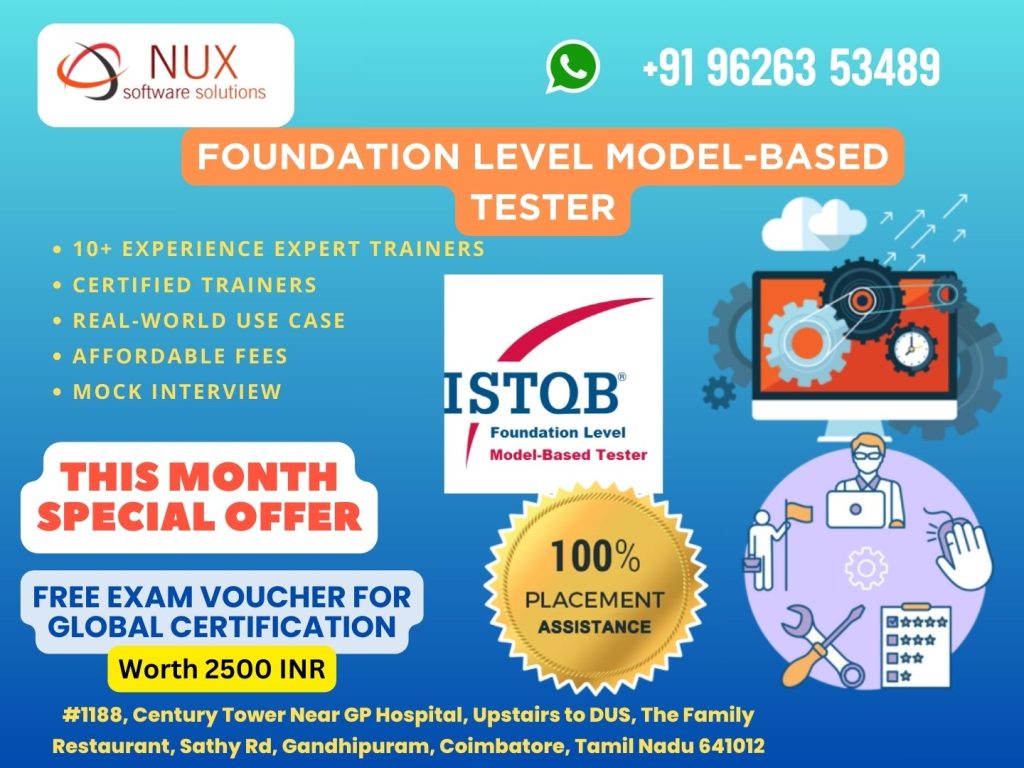Advanced Security Tester

ISTQB Advanced Level Security Tester Training in Coimbatore
Course Overview
The ISTQB Advanced Level Security Tester certification is designed for professionals who want to specialize in security testing. It offers deep insights into the principles, processes, and tools necessary to identify security vulnerabilities in software systems and applications. This training in Coimbatore prepares participants to plan, perform, and evaluate security testing as part of a broader testing strategy.
The course builds upon the ISTQB Foundation Level and provides in-depth knowledge of risk assessment, threat modeling, vulnerability scanning, penetration testing, and compliance frameworks. Participants will learn how to assess security risks and design appropriate testing strategies for mitigating those risks across various development lifecycles.
Security testing has become crucial in today’s software-driven world, where protecting data and maintaining system integrity are non-negotiable. This certification empowers professionals to ensure that software systems are resilient to security threats and meet compliance and governance standards.
What You’ll Learn
Security testing principles and objectives
Security testing techniques and approaches
Risk assessment and threat modeling
Security test planning and execution
Understanding common security vulnerabilities (OWASP Top 10)
Using tools for security scanning and penetration testing
Security testing in Agile, DevOps, and CI/CD pipelines
Security standards and legal compliance considerations
Who Should Attend?
Software Testers and QA Engineers
Security Analysts and Engineers
Test Managers focused on security compliance
Developers working on secure coding practices
Anyone interested in specializing in cybersecurity testing
Key Benefits
Gain an ISTQB-recognized qualification in a high-demand field
Master the techniques to uncover security issues early in development
Improve your organization’s ability to deliver secure applications
Understand how to integrate security testing with DevOps workflows
Build a strong foundation for further specialization in ethical hacking or penetration testing
Why Choose Us in Coimbatore?
Expert trainers with real-world security testing experience
Hands-on labs using modern tools like Burp Suite, OWASP ZAP, Kali Linux
Practical case studies with web, mobile, and API security testing scenarios
Comprehensive exam preparation support
Flexible batch timings and placement guidance
Secure your place in the digital defense frontier. Join our ISTQB Advanced Level Security Tester course in Coimbatore and build future-ready cybersecurity skills.
Course Syllabus
Modules
Introduction to this Syllabus
0.1 Purpose of this Document
0.2 Overview
0.3 Examination
0.4 How this Syllabus is Organized
0.5 Definitions
0.6 Level of Detail
0.7 Learning Objectives / Level of Knowledge
1 The Basis of Security Testing
1.1 Security Risks
1.1.1 The Role of Risk Assessment in Security Testing
1.1.2 Asset Identification
1.1.3 Analysis of Risk Assessment Techniques
1.2 Information Security Policies and Procedures
1.2.1 Understanding Security Policies and Procedures
1.2.2 Analysis of Security Policies and Procedures
1.3 Security Auditing and Its Role in Security Testing
1.3.1 Purpose of a Security Audit
1.3.2 Risk Identification, Assessment and Mitigation
1.3.3 People, Process and Technology
2. Security Testing Purposes, Goals and Strategies
2.1 Introduction
2.2 The Purpose of Security Testing
2.3 The Organizational Context
2.4 Security Testing Objectives
2.4.1 The Alignment of Security Testing Goals
2.4.2 Identification of Security Test Objectives
2.4.3 The Difference Between Information Assurance and Security Testing
2.5 The Scope and Coverage of Security Testing Objectives
2.6 Security Testing Approaches
2.6.1 Analysis of Security Test Approaches
2.6.2 Analysis of Failures in Security Test Approaches
2.6.3 Stakeholder Identification
2.7 Improving the Security Testing Practices
3. Security Testing Processes
3.1 Security Test Process Definition
3.1.1 ISTQB Security Testing Process
3.1.2 Aligning the Security Testing Process to a Particular Application Lifecycle Model
3.2 Security Test Planning
3.2.1 Security Test Planning Objectives
3.2.2 Key Security Test Plan Elements
3.3 Security Test Design
3.3.1 Security Test Design
3.3.2 Security Test Design Based on Policies and Procedures
3.4 Security Test Execution
3.4.1 Key Elements and Characteristics of an Effective Security Test Environment
3.4.2 The Importance Of Planning and Approvals in Security Testing
3.5 Security Test Evaluation
3.6 Security Test Maintenance
4. Security Testing Throughout the Software Lifecycle
4.1 The Role of Security Testing in a Software Lifecycle
4.1.1 The Lifecycle View of Security Testing
4.1.2 Security-Related Activities in the Software Lifecycle
4.2 The Role of Security Testing in Requirements
4.3 The Role of Security Testing in Design
4.4 The Role of Security Testing in Implementation Activities
4.4.1 Security Testing During Component Testing
4.4.2 Security Test Design at the Component Level
4.4.3 Analysis of Security Tests at the Component Level
4.4.4 Security Testing During Component Integration Testing
4.4.5 Security Test Design at the Component Integration Level
4.5 The Role of Security Testing in System and Acceptance Test Activities
4.5.1 The Role of Security Testing in System Testing
4.5.2 The Role of Security Testing in Acceptance Testing
4.6 The Role of Security Testing in Maintenance
5.0 Testing Security Mechanisms
5.1 System Hardening
5.1.1 Understanding System Hardening
5.1.2 Testing the Effectiveness of System Hardening Mechanisms
5.2 Authentication and Authorization
5.2.1 The Relationship Between Authentication and Authorization
5.2.2 Testing the Effectiveness of Authentication and Authorization Mechanisms
5.3 Encryption
5.3.1 Understanding Encryption
5.3.2 Testing the Effectiveness of Common Encryption Mechanisms
5.4 Firewalls and Network Zones
5.4.1 Understanding Firewalls
5.4.2 Testing Firewall Effectiveness
5.5 Intrusion Detection
5.5.1 Understanding Intrusion Detection Tools
5.5.2 Testing the Effectiveness of Intrusion Detection Tools
5.6 Malware Scanning
5.6.1 Understanding Malware Scanning Tools
5.6.2 Testing the Effectiveness of Malware Scanning Tools
5.7 Data Obfuscation
5.7.1 Understanding Data Obfuscation
5.7.2 Testing the Effectiveness of Data Obfuscation Approaches
5.8 Training
5.8.1 The Importance of Security Training
5.8.2 How to Test the Effectiveness of Security Training
6.0 Human Factors in Security Testing
6.1 Understanding the Attackers
6.1.1 The Impact of Human Behavior on Security Risks
6.1.2 Understanding the Attacker Mentality
6.1.3 Common Motivations and Sources of Computer System Attacks
6.1.4 Understanding Attack Scenarios and Motivations
6.2 Social Engineering
6.3 Security Awareness
6.3.1 The Importance Of Security Awareness
6.3.2 Increasing Security Awareness
7.0 Security Test Evaluation and Reporting
7.1 Security Test Evaluation
7.2 Security Test Reporting
7.2.1 Confidentiality of Security Test Results
7.2.2 Creating Proper Controls and Data Gathering Mechanisms for Reporting Security Test Status
7.2.3 Analyzing Interim Security Test Status Reports
8.0 Security Testing Tools
8.1 Types and Purposes of Security Testing Tools
8.2 Tool Selection
8.2.1 Analyzing and Documenting Security Testing Needs
8.2.2 Issues with Open Source Tools
8.2.3 Evaluating a Tool Vendor's Capabilities
9.0 Standards and Industry Trends
9.1 Understanding Security Testing Standards
9.1.1 The Benefits of Using Security Testing Standards
9.1.2 Applicability of Standards in Regulatory Versus Contractual Situations
9.1.3 Selection of Security Standards
9.2 Applying Security Standards
9.3 Industry Trends
9.3.1 Where to Learn of Industry Trends in Information Security
9.3.2 Evaluating Security Testing Practices for Improvements



